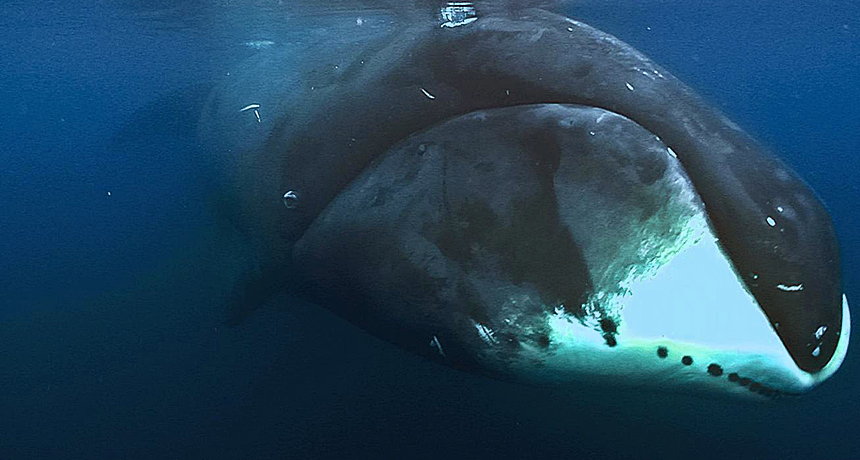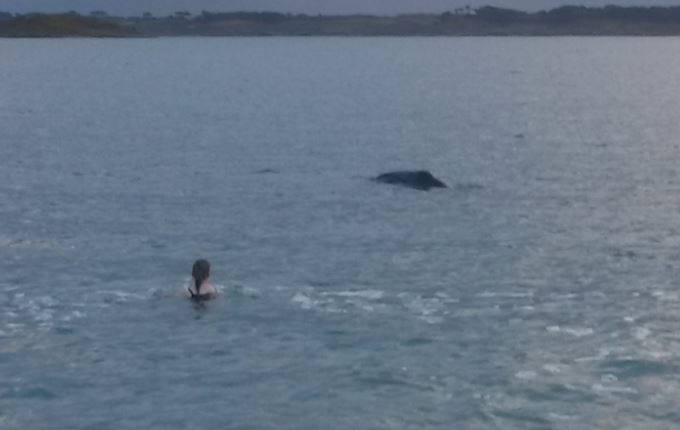In 2015, a very strange visitor appeared off the shores of the UK. More suited to navigating ice in the arctic than the shallows of Cornwall, it was a huge surprise when it was determined that a bowhead whale had found itself so far from home. Since, only one other individual has ever made its way back to the UK, a year later in 2016. In this blog, we’ll take a look at the biology, behaviour, and remarkable life-histories of these cold-water giants (and very occasional visitors!).

Bowhead whales are baleen whales belonging to the family Balaenidae, and the only representative of the genus Balaena. Endemic to arctic and sub-arctic habitats, they are huge animals, growing between 18-20m/to 120,000lbs with dark, rotund bodies and some white colouration on their chins. Their heads are large and triangular, making up about 40% of their total body length, an adaptation perfect for breaking through thick sea ice. Their bulky heads are coupled with a strongly arched mouthline which conceals the longest baleen plates of any whale, growing up to 4m long. Bowhead whales also win the title for the thickest blubber of any cetacean (up to 50cm thick!), another adaptation living its entire life in an extreme environment where thermoregulation is key to survival. Interestingly, bowhead whales have also been found to possess a unique organ in their oral cavity, made up of highly vascularised tissue that holds and circulates a large amount of blood. It is thought that this organ plays an additional role in thermoregulation, namely preventing hyperthermia and controlling heat loss, but scientists have suggested it might also play as-yet unidentified roles in locating prey or growth (Ford et al. 2013). Like other balaenid whales, they have a distinctive ‘V’ shaped blow formed by paired blowholes, and do not possess a dorsal fin. Now we know what they look like, what do these whales get up to?
“bowhead whales vocalise extensively and complexly – often referred to as the ‘jazz musicians’ of the sea due to the versatility and improvisation of their songs”
Socially, bowhead whales tend to stay alone or in small groups unless temporarily aggregating with others. This might occur during mating, migrating (which is dictated by the retreat and advance of sea ice), or feeding. Unlike the lunge-feeding style of rorqual whales (minke, blue, fin…), where grooves on the throat help engulf masses of water and prey, bowhead whales filter out copepods, krill, and other crustaceans passively as they swim (Lowry et al. 2004; Pomerleau et al. 2011). Like other cetaceans, bowhead whales vocalise extensively and complexly – often referred to as the ‘jazz musicians’ of the sea due to the versatility and improvisation of their songs (Tervo et al. 2011). Unlike other well-known vocal cetaceans such as humpback whales, however, bowhead songs are not thought to be shared across whole populations. Instead, they’re thought to be shared just among small groups (Erbs et al. 2021). This might be related to the hypothesised purpose of these vocalisations, which is thought to be related to mating behaviour wherein males try and attract multiple females (Tervo et al. 2009).
Today, bowhead whales are classed as of Least Concern by the IUCN, numbering 15,000+ animals worldwide. However, like their relatives the right whales, bowhead whales were once subjected to extreme commercial whaling pressures in the late 19th and early 20th century. Originally numbering 5 times their current population, bowhead whales were hunted for their meat, oil, and blubber until whaling gradually declined, leaving about 3,000 individuals worldwide. Today, bowhead whales are recovering as a species and are only hunted for subsistence by indigenous peoples in Alaska, Russia, and Canada, such as the Iñupiaq and St Lawrence Island Siberian Yupik community. Whilst hunting is a sensitive topic for lovers of cetaceans, cetaceans are revered in native cultures and the centuries of ecological knowledge and observations passed down through indigenous communities has allowed scientists to work collaboratively with them to vastly increase our understanding of these arctic specialists. In fact, native communities led the way for science to uncover one of the most incredible features of bowhead whale ecology and life history!
Oral histories passed down through the native community have long focused on encounters with whales. Incredibly, the tales of these experiences led them to the realisation that grandparents, children, and grandchildren were all observing the same individual whales, which they identified by becoming familiar with unique scars and distinct colouration patterns. This suggested the lifespan of bowheads could potentially be hundreds of years. In the late 1980s and 1990s, this was further supported by the discovery of artefacts inside the tissues of harvested whales. The community knew these objects to be spear points, made of materials that they had not used for centuries – ageing the whales they harvested at over 100 years old. Then, in May 2007, a whaling crew brought a bowhead to shore with a mystery piece of metal lodged inside it. Upon closer examination, it was found that the object was in fact a bomb lance fragment, used as part of a whaling weapon dating back to the 1870-1880’s.

This meant that the whale had to be at least 115 years old, corroborating the ecological knowledge and experiences of the Inuit peoples. Whilst the spear points had been found well over a decade earlier, this was the first to garner mass attention within the scientific community. Previously, a study undertaken in 1999 estimated multiple bowhead whales to be over 100 years old, with one supposedly reaching 211, using a technique called aspartic acid racemization. This involves analysing amino acids taken from the eye and determining the rate at which acids switch between different forms (isomers), which in turn can age an animal (George et al. 1999; Rosa et al. 2012). However, these conclusions were controversial at the time and it is only now, with new insights such as the precise dating of artifacts such as the bomb lance fragment and stronger connections with native communities, that scientists can say with certainty that bowhead whales could well live to 200 years or beyond, making them one of the longest-lived mammals in the world. For centuries, traditional indigenous knowledge has said that bowhead whales “live two human lifetimes” – an idea most of us are only now catching up with.
“for centuries, traditional indigenous knowledge has said that bowhead whales “live two human lifetimes”
For mammals, living over 100 years is a tall order. For humans, older age is associated with an increase in diseases such as cancer, and ageing takes its toll on our bodies. So, how do bowhead whales survive? Bowhead whale biology reveals unique mutations, selection pressures, and gains and losses involving genes associated with disease, ageing, immune response, and diet. For example, bowhead whales have been found to possess a mutation in the ERCC1 gene, which is involved in DNA repair. Better DNA repair reduces the risk of cancerous cells mutating and proliferating, so despite them having over 1000x the number of cells we do, their cancer risk is not increased. Insulin signalling is also altered in bowheads. Insulin is thought to be heavily involved in longevity (Rincon et al. 2005), and changes in these insulin pathways in the bowhead whale are suspected to afford them a longer lifespan but also make them better adapted to lipid-poor diets, meaning they are less likely to suffer with dietary disease (Seim et al. 2014; Keane et al. 2015). These molecular changes could potentially help us understand disease and ageing in humans!
Whilst we’re unlikely to see any more bowhead whales in the UK any time soon, these unusual arctic giants are perhaps one of the most striking and impressive cetaceans in the world, and more than worthy of a moment in the spotlight.

Lucy
@lucwhyy
Sea Watch Foundation Volunteer
Feature Blogger
Tervo, O., Christoffersen, M., Parks, S., Møbjerg Kristensen, R. and Teglberg Madsen, P. (2011). Evidence for simultaneous sound production in the bowhead whale (Balaena mysticetus). The Journal of the Acoustical Society of America, 130(4), pp.2257-2262.
Rosa, C., Zeh, J., Craig George, J., Botta, O., Zauscher, M., Bada, J. and O’Hara, T. (2012). Age estimates based on aspartic acid racemization for bowhead whales (Balaena mysticetus) harvested in 1998-2000 and the relationship between racemization rate and body temperature. Marine Mammal Science, 29(3), pp.424-445.
Rincon, M., Rudin, E. and Barzilai, N. (2005). The insulin/IGF-1 signaling in mammals and its relevance to human longevity. Experimental Gerontology, 40(11), pp.873-877.
Keane, M., Semeiks, J., Webb, A., Li, Y., Quesada, V., Craig, T., Madsen, L., van Dam, S., Brawand, D., Marques, P., Michalak, P., Kang, L., Bhak, J., Yim, H., Grishin, N., Nielsen, N., Heide-Jørgensen, M., Oziolor, E., Matson, C., Church, G., Stuart, G., Patton, J., George, J., Suydam, R., Larsen, K., López-Otín, C., O’Connell, M., Bickham, J., Thomsen, B. and de Magalhães, J. (2015). Insights into the Evolution of Longevity from the Bowhead Whale Genome. Cell Reports, 10(1), pp.112-122.
























